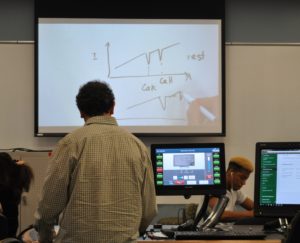ASTR 111/113: A Free Trip to the Stars – and Back
Guiding more than 1,000 non-science majors effortlessly through the Universe — on a dime — was the OER challenge recently led by Dr. Rebecca Ericson along with her co-PIs Drs. Mario Gliozzi and Gabriele Belle.
Students interested in fulfilling a lab science requirement arrive at Astronomy 111 and 113 with a wide-range of prior experience, or inexperience, in the subject, thus necessitating Ericson’s intention to create learning materials that are “accessible and inspirational, yet intellectually challenging.” Moreover, Ericson wanted to allow the inclusion of astronomy “news”, rather than following the lines of a traditional format textbook. Ericson explains, “At the current pace of science exploration, it’s important to make room for new and exciting developments in the field.”
Step one for Ericson was to scour OER resources for a suitable beginning point for a text. She found it at OpenStax through Rice University. (Although the OpenStax text was still in the beta stage when they first used it, she felt the materials fit the course well.) From there, she allotted the 4-VA funding to colleagues Gliozzi and Belle to begin the task of locating or developing resources to supplement the text; including videos, short activities and other materials. Moreover, because both courses are taught in a variety of settings – from face to face, to all online, to hybrid, she also wanted to build in instructor materials and provide the ability to create narrated PowerPoints as the course moved through each semester.

As the new materials came together, Gliozzi began to utilize the course materials in a “flipped” classroom– assigning recorded online lectures prior to the class meeting date; thus allowing students to arrive in class with foundational knowledge of the particular topic and able to spend the time in hands-on active- learning mode.
Ericson reports that one overarching goal in the course re-design was to save students the cost of an expensive textbook. She notes, “My prior experience was teaching physics and astronomy at the community college level; it was always so distressing to see students pay more for their soon-to-be outdated textbook than the cost of the class credits.”
Before the OER re-design, students were paying $100 to $200 on textbooks. Today, that has dropped to zero for sections using the OER materials. What’s more, Ericson reports, “The students received the new materials very enthusiastically – they seem to be really enjoying the fresh approach to the class.”
“When I came across the 4-VA grant, I saw it as a great opportunity to explore what’s out there for our students at Mason to give them a better experience in this class. The grant gave us the financial boost we needed to make that goal a reality,” Ericson concludes.

